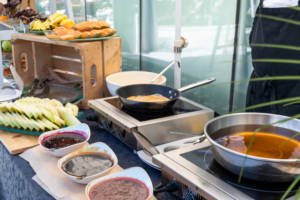
DIY food stations have become a popular way to serve food at weddings in a fun and unique way, and enable you to showcase different cuisines.
Designing your reception meal is a fun part of wedding planning, but it can also be one of the hardest. Sit-down plated dinners, buffets, food trucks, spreads, and appetizer stations all have their advantages and drawbacks. Whether your guests have unique dietary needs, you’re concerned about cost, or you just want to do something different, DIY food stations may be the perfect solution to your reception meal conundrum.
A Quick Review of Food Stations
Food stations have already been popular for several years. Martha Stewart Weddings‘ Blythe Copeland mentions that they’re great alternatives to buffets. They’re typically scattered around a room, with each station offering a different type of food, and guests can come and go as they please. With this setup and logistics, they don’t generate long queues of people waiting to get their meal. You can also give each station unique décor to complement the cuisine it offers or your wedding’s overall theme.
Customizable Dishes and Bowl Food
Wedding Wire Canada’s Alice Prendergast projects customizable food as one of 2020’s biggest culinary trends. This concept takes food stations a step further by allowing your guests to individually create their dishes. Pizzas, tacos, and burgers are typical options, but many dishes can work with this concept. Bridal Guide showcases several other ideas for interactive food stations.
Prendergast also mentions bowl foods as another popular choice for DIY stations. Bowl foods grabbed international headlines when Harry and Meghan, Duke and Duchess of Sussex, served them at their May 2018 wedding. Bowl foods usually include a few key components:
- A starchy base such as rice, noodles, or quinoa
- Chopped fruit or veggies
- Meat, poultry, fish, or plant-based protein
- Flavorful touches like sauces, marinades, or toppings
Bowl food encompasses a wide range of world cuisines: Hawaiian, Cuban, Indian, and Japanese, to name a few. It’s pretty easy to find options that will please your crowd, so you’re only limited by your imagination and budget.
Are DIY Food Stations Right for Your Wedding?
As you think about self-serve food stations for your event, you should consider some important details. You may pay more for labor for replenishing food or if any stations need to be manned–for instance, meat carving or oyster shucking. Don’t forget about any seating issues, either. You’ll have to be careful if you have relatives who don’t get along or guests who use mobility aids.
Tips for Successful Food Stations
Ready to plan your self-serve food stations? Your first step is finding the right caterer. The Knot encourages couples to come up with a vision for their event before shopping for caterers, venues, or anything else. The planning process usually begins about a year before the big day, so that gives you some time to find vendors that best fit with your concept and theme. If you find the perfect caterer first, don’t forget to ask potential venues if they allow outside food services. You’ll want to make sure your chosen venue has enough space and an ideal layout to support multiple food stations.
While you’re at it, don’t forget to accommodate guests with food allergies or dietary restrictions. Hopefully, you’ll gather this information either early in the planning process or request it from attendees with their RSVPs. Ask your caterer to clearly label items on each food station. Consider separate stations for people with severe allergies to avoid cross-contamination, especially with serving utensils.
Fantastic Food Options for Your Special Day
Your wedding is a chance to unleash your creativity and choose new approaches to everyday things. Customizable and bowl foods are the latest trends, but they’re also perfect ways to spice up your reception cuisine. Self-serve DIY food stations are a fun way to present these awesome foods. With smart planning and budgeting, you’ll give your guests an unforgettable experience.


